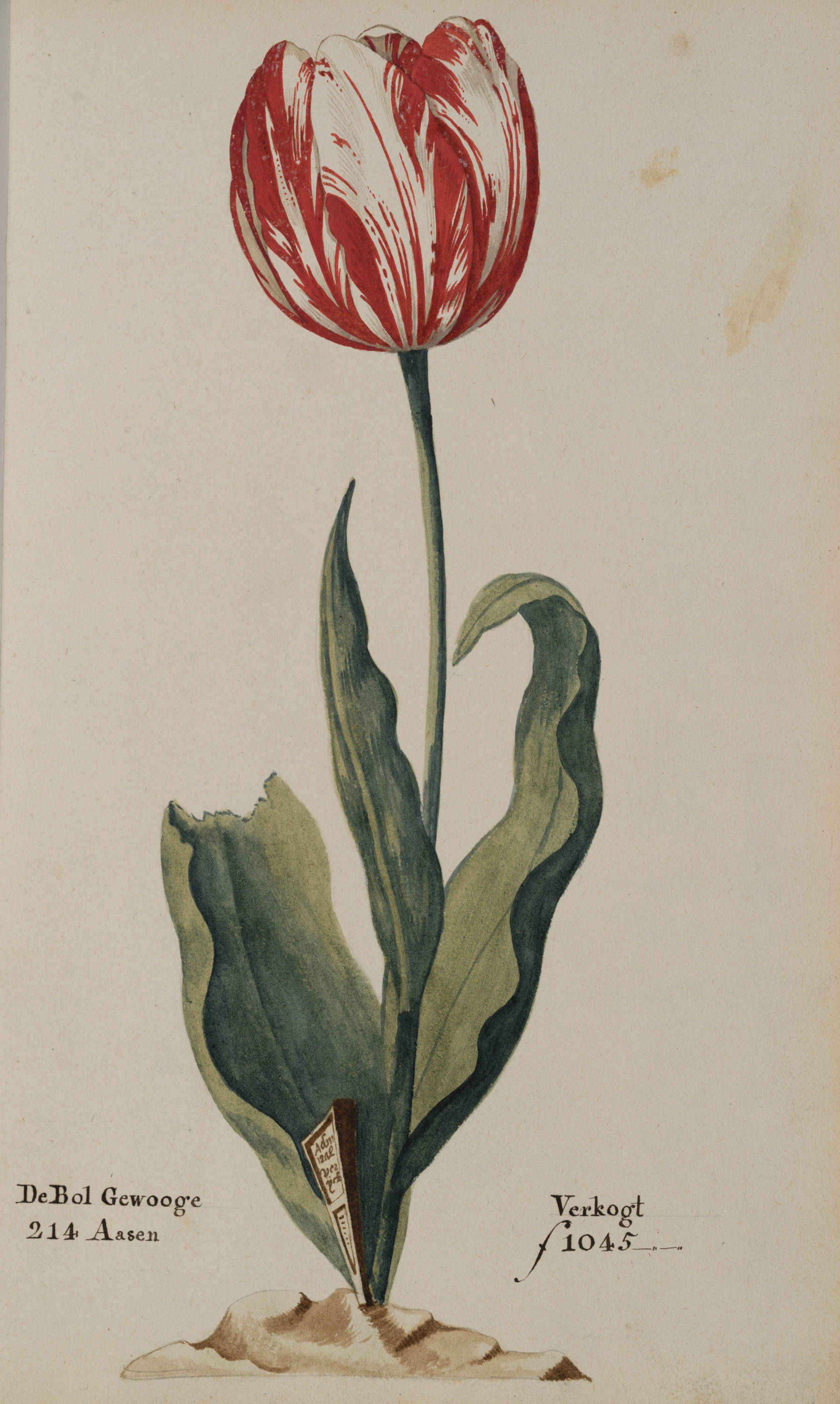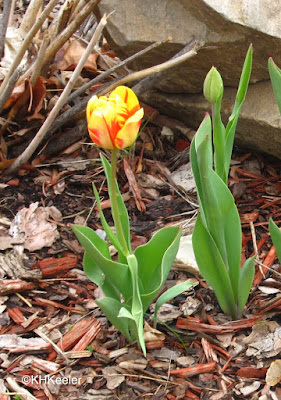The Dutch were smart traders, but there were economic lessons to learn. Stock and commodity markets didn't exist in the 1500s. In the early 1600s, they were slowly coming into existence with people meeting in coffee houses to buy and sell. Buying into a ship was pretty concrete. Investing in tulips involved futures. Nobody understood the risks of futures.
It is easiest to explain with a scenario:
Your ship just came in and you made a huge profit. In conversation with Hans, he boasts of his flame tulip, called Admiral Verjick (photo below). When you suggest you'd like to own one, he says there aren't any others. So you want one even more! Reluctantly, Hans admits that his tulip has formed a small offset (bud on the bulb) and he might be willing to sell it to you. You quickly offer him an amazing amount of money, 200 guilders, to overcome his reluctance and be sure he doesn't sell it to anyone else. He agrees, but tells you that now, October, is not the time to transplant tulips. It's yours, but he'd recommend you send your gardener to get it in June. You agree. You shake hands with Hans and fill out a contract. (The Dutch were long on written contracts, which is why we know so much about a tulip bubble 400 years ago. Oh, and 200 guilders is not $200 but more than the average Dutch worker earns in a year.)
 |
| Admiral Verijck tulip, from Wikipedia commons |
In November you are telling Pieter that you have an Admiral Verijck tulip coming in the spring. Pieter recently made a lot selling black pepper from the East Indies. When you say "its the only one on Hans' plant" he offers you 400 guilders for it. You are torn. Your ship needs major repairs...so when he goes to 500, you give in and sell the rights to the offset, still in the ground in Hans' garden, to Pieter.
Sometime in December, Pieter sells the rights to the offset again, to Jakob for 1000 guilders.
In the spring, the offset passes from Hans to you to Pieter to Jakob. Everyone is delighted. Hans, you and Pieter made amazing profits and Jakob got one of two Admiral Verijck tulips in all of Holland, probably in all the world.
The word gets out. Many people are shocked. "So much money for a silly bulb?!" The bishop gives a sermon condemning whatever it was you did: it just doesn't seem right! (Selling and reselling something you don't actually take possession of?! Never heard of it!) But other people take note--look at all that money made from tulip bulbs!
So began a bubble. Serious gardeners and collectors bought and sold expensive, rare bulbs. But the lure of quick wealth brought in speculators with no interest in tulips, only in making money trading tulips. All levels of tulips were affected, ordinary one-color ones but especially the rare, slow-growing flame patterns.
All sorts of people warned it was a bad idea, but the prices kept on rising.
The record, as far as we know, was paid for the tulip called Semper Augustus (link), 13,000 guilders. At that time, 10,000 guilders would buy a house in an exclusive neighborhood, with garden and coach. The average annual income was about 150 guilders. Google says the average annual income in the US is 51,939. This tulip traded for 86 times that, or--I did the math--4.5 million dollars.
 |
| A house on the canal in Amsterdam was traded for a tulip bulb |
Then in early February, 1637, at the coffee house where trading normally took place, a seller offered tulips for sale...and nobody bid. He lowered his price to get a sale. Everyone watching suddenly became fearful: they held contracts for tulips which they couldn't pay unless the prices stayed high or rose. The obvious result followed: each of them tried to sell their tulip futures to protect themselves, nobody was buying in the face of the panic, and the price of even rare tulips dropped cataclysmically overnight. The bubble burst.
How dreadful the end of the bubble was varies with the author you read. Several people certainly did lose everything, for example if they had sold tangible property to buy tulips. Because there were contracts, the situation was argued in the courts for the next decade. But you can't get payment if the person has nothing. More often, I think, what was lost was the dream of great fortune. If the transaction above (Hans to you to Pieter to Jakob) had been in 1636, then after February, Jakob wouldn't pay 1000 guilders, Pieter would get nothing, you'd get nothing and Hans in disgust would keep his rare tulip. Lost dreams but not bankruptcy. Plus loss of trust and friendship if, for example, you honored the contract and paid Hans but Pieter didn't pay you. Certainly some families were ruined.
And it has made a dramatic lesson in economic bubbles ever since.
I priced tulips online. The most expensive I could find was about $20 a bulb, but 20 bulbs for $5 is more common. Probably there are tulips at $40 a bulb, but nothing like in 1635.
I next went looking for Semper Augustus. Could I own the famous tulip?
No. It died out.
It turns out that the flame pattern indicates a virus, tulip breaking virus, a mosaic virus (general, the most famous mosaic virus). It weakens the plant so it grows more slowly and has fewer offsets than uninfected tulips. Within a century the famous tulips of the tulip bubble had all died out.
Tulip breaking virus is still out there. It still infects tulips and makes lovely flame patterns. But the international tulip trade does not and will not sell you virus-infected tulips. The only way to get a flame pattern tulip is for the virus to attack your tulips.
Could this tulip, in my garden, be an example?
Plants have been rare wildly expensive commodities. The tulip bubble is a dramatic example of that but by no means the only one. Demand can push the price of rare items to very high levels--we just don't think a plant could be that desirable. It is easier to imagine a bidding war over a fine emerald than an lovely orchid...let alone a tulip. Why is that?
Enjoy tulips!
For more of the details on the tulip bubble, also called tulipmania and tulipomania, search online, there are many articles about it. See also the books listed below.
References
Dash, M. 1999. Tulipomania. Three Rivers Press, New York.
Galbraith, J. K. 1999. A short history of financial euphoria. Whittle Direct Books, New York.
Goldgar, A. 2007. Tulipmania. University of Chicago Press, Chicago.
Pavord, A. 1999. The tulip. Bloomsbury Press, New York.
Pollan, M. 2002. The botany of desire. Random House, New York.
'
Kathy Keeler, A Wandering Botanist
More at awanderingbotanist.com


Kathy, I always enjoy this story when you tell it!! Wonder if I could create a crabgrass bubble and make my lawn worth something...nah, way too prolific I think! ;0)
ReplyDelete